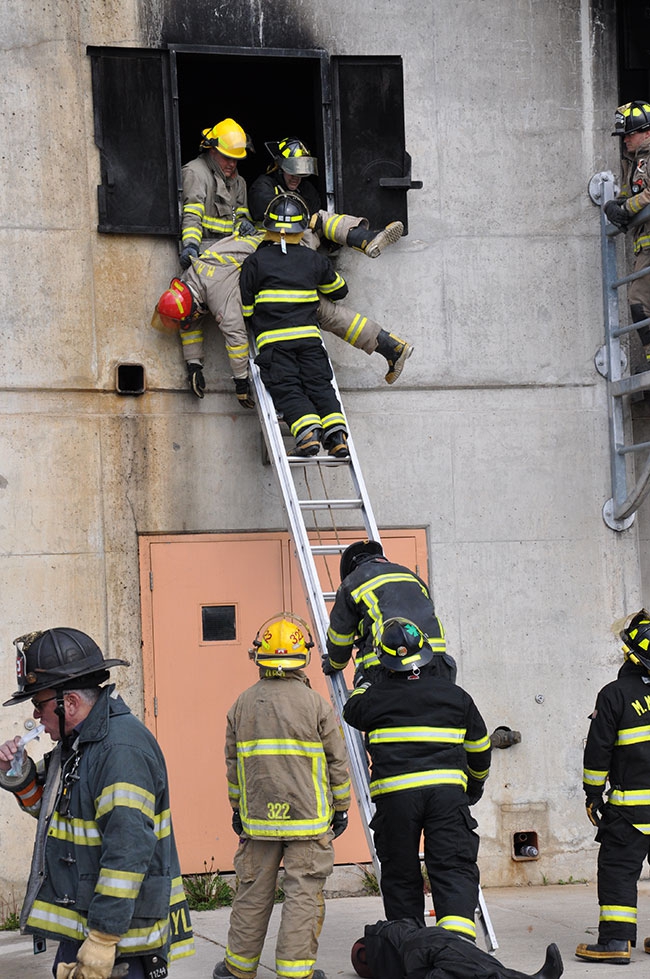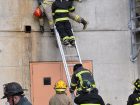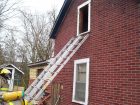
Back to Basics: July 2015
Mark Van
Features Fire Ground TrainingThere are many different rapid-intervention team (RIT) techniques for rescuing a downed firefighter from a structure. Most techniques are employed based on specific situations, such as ropes for a sub-level rescue or the Denver drill for a narrow aisle and high window sill. But there are some commonalities among different techniques that can be applied in a very basic way.
 After the downed firefighter is lifted up to and positioned out of the window One of the most basic ways to rescue or remove a downed/injured firefighter from a structure is by using the window. Mark van der Feyst shares techniques for RIT window rescues.
After the downed firefighter is lifted up to and positioned out of the window One of the most basic ways to rescue or remove a downed/injured firefighter from a structure is by using the window. Mark van der Feyst shares techniques for RIT window rescues.One of the most basic ways to rescue or remove a downed/injured firefighter from a structure is by using the window.
So why the window? In accordance with local, provincial and national building codes, almost all buildings have windows to provide natural light, a means of escape and also natural air ventilation for the occupants. This provision of the building code also provides fire services with a quick means of egress for both the RIT members and for the downed firefighter. The easiest removal path is via the nearest means of egress – more often than not it is a window.
One of the more common window-rescue techniques is to make an enlarged opening. Firefighters are able to make a window into a door by cutting and enlarging the wall section below the sill down to the floor level on either side of the jack posts, and also horizontally to either one side. This type of window rescue is easy to accomplish but requires the manpower to prep the window and make it into a larger opening.
Removing a downed firefighter through a window that is not enlarged requires the firefighter to be lifted up to the sill and then – if the window is on an elevated floor – down a ladder. The hardest part of the window rescue is lifting the downed firefighter from the floor up to the window sill and then out the window. RIT firefighters need to be proficient in different techniques to lift a person up to a window sill. There are a few options to consider for this: the 2:1 mechanical-advantage system, the fulcrum lift and the ramp lift.
The 2:1 mechanical-advantage system uses a rope, a set of pulleys and carabineers, a ground ladder, and a guiding crew, to lift a firefighter up off the floor, out the window and down to the ground. The mechanical advantage system requires four RIT firefighters, two of whom will employ basic hauling practices to accomplish the lift. Once the downed firefighter is lifted up off the floor, he or she is redirected out the window and then lowered down to the ground. See the July 2013 issue of Canadian Firefighter for a more detailed description of the 2:1 mechanical-advantage system.
The fulcrum lift and the ramp lift are two options for which the RIT firefighters will have to exert physical strength to lift a downed firefighter. For the fulcrum lift, the downed firefighter is positioned so that his feet face the window wall. The RIT members then push or bring the downed firefighter closer to the wall so that his knees are bent and his buttocks is as close to his feet as possible. This position of the knees is the fulcrum for the lift. The RIT members then take hold of the downed firefighter around and under the arms and push upwards and into the downed firefighter. The RIT firefighter waiting on the ladder outside can assist by reaching in and grabbing the downed firefighter’s wrist or SCBA shoulder straps and pulling upwards.
The ramp lift involves creating a ramp out of a door from the interior of the building or a roof ladder. Insert the roof ladder or door through the window so that one end rests on the window sill and the other end is positioned on the floor. Generally a roof ladder is longer and stronger compared to a door, but it depends on the type of door being used. With the ramp in place, the downed firefighter is dragged up and unto the door or roof ladder so that the RIT members can then lift up the floor end of the ramp and slide the door or ladder and firefighter out the window to safety. This technique works well for a ground-level window and rescue. Using this technique on a second storey is very difficult since the downed firefighter will have to be transitioned from the ramp into the arms of a RIT firefighter on a ground ladder.
There are three different ways to take the rescued firefighter down a ground ladder: across the arms, knee drop and cradle. The knee drop and the cradle are the two most difficult ways because they are slower than the cross-arm method and only used when the feet of the downed firefighter are presented first out the window. The simplest and most common method is across the arms. As you can see in photo 1, the downed firefighter was lifted up to the window, positioned out the window and placed across the arms of the RIT firefighter horizontally. One arm goes under the armpit and the other arm goes through the legs of the downed firefighter. The RIT firefighter has both hands on the beam of the ladder so as to maintain control all the way down.
If the downed firefighter is larger, two RIT members may be required to bring the firefighter down the ladder. In this case, use two ground ladders placed side by side below the window sill (as pictured in photo 2) and have both RIT members secure the downed firefighter across their arms.
Using windows is a quick and relatively easy way to remove a downed firefighter, but these methods will only work with much practice and persistence.
Mark van der Feyst has been in the fire service since 1999; he is a full-time firefighter in Ontario. He teaches internationally and is the lead author of Pennwell’s Residential Fire Rescue . Mark@FireStarTraining.com
Print this page

